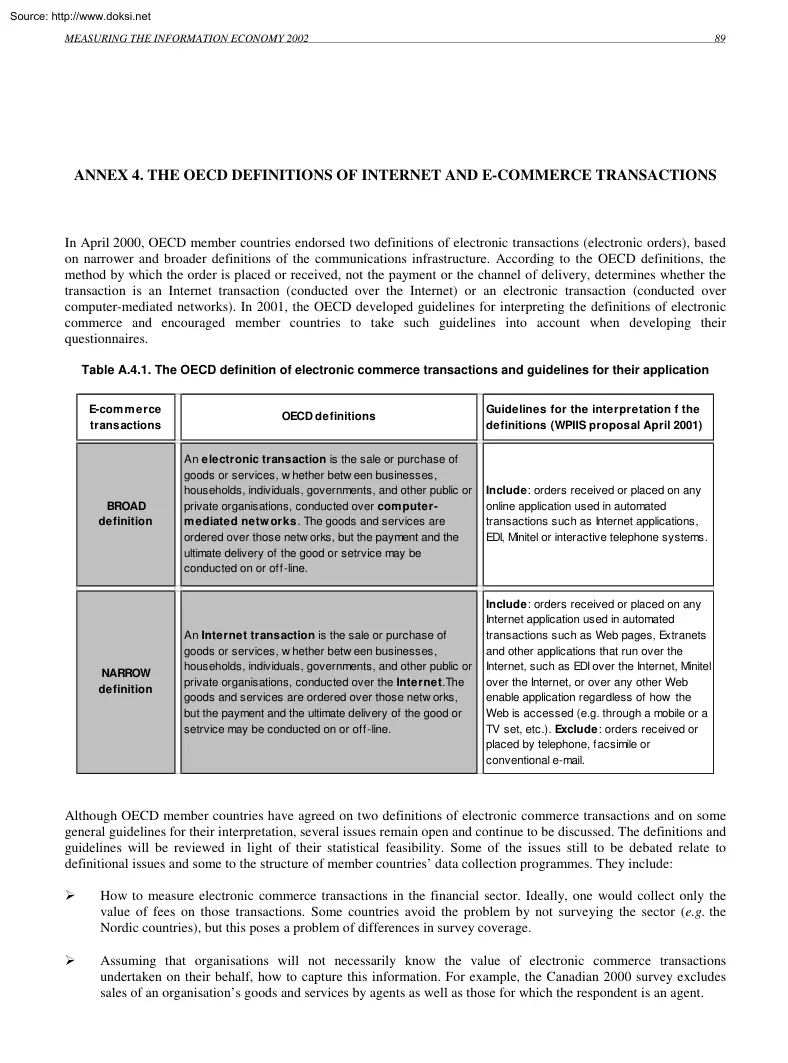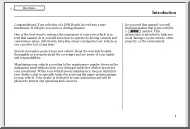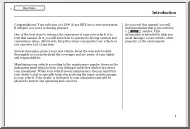Comments
No comments yet. You can be the first!
Content extract
Source: http://www.doksinet MEASURING THE INFORMATION ECONOMY 2002 89 ANNEX 4. THE OECD DEFINITIONS OF INTERNET AND E-COMMERCE TRANSACTIONS In April 2000, OECD member countries endorsed two definitions of electronic transactions (electronic orders), based on narrower and broader definitions of the communications infrastructure. According to the OECD definitions, the method by which the order is placed or received, not the payment or the channel of delivery, determines whether the transaction is an Internet transaction (conducted over the Internet) or an electronic transaction (conducted over computer-mediated networks). In 2001, the OECD developed guidelines for interpreting the definitions of electronic commerce and encouraged member countries to take such guidelines into account when developing their questionnaires. Table A.41 The OECD definition of electronic commerce transactions and guidelines for their application E-com m erce transactions OECD definitions Guidelines for
the interpretation f the definitions (WPIIS proposal April 2001) BROAD definition An electronic transaction is the sale or purchase of goods or services, w hether betw een businesses, households, individuals, governments, and other public or private organisations, conducted over com puterm ediated netw orks. The goods and services are ordered over those netw orks, but the payment and the ultimate delivery of the good or setrvice may be conducted on or off-line. Include: orders received or placed on any online application used in automated transactions such as Internet applications, EDI, Minitel or interactive telephone systems. An Internet transaction is the sale or purchase of goods or services, w hether betw een businesses, households, individuals, governments, and other public or private organisations, conducted over the Internet.The goods and services are ordered over those netw orks, but the payment and the ultimate delivery of the good or setrvice may be conducted on or
off-line. Include: orders received or placed on any Internet application used in automated transactions such as Web pages, Extranets and other applications that run over the Internet, such as EDI over the Internet, Minitel over the Internet, or over any other Web enable application regardless of how the Web is accessed (e.g through a mobile or a TV set, etc.) Exclude: orders received or placed by telephone, facsimile or conventional e-mail. NARROW definition Although OECD member countries have agreed on two definitions of electronic commerce transactions and on some general guidelines for their interpretation, several issues remain open and continue to be discussed. The definitions and guidelines will be reviewed in light of their statistical feasibility. Some of the issues still to be debated relate to definitional issues and some to the structure of member countries’ data collection programmes. They include: ½ How to measure electronic commerce transactions in the financial
sector. Ideally, one would collect only the value of fees on those transactions. Some countries avoid the problem by not surveying the sector (eg the Nordic countries), but this poses a problem of differences in survey coverage. ½ Assuming that organisations will not necessarily know the value of electronic commerce transactions undertaken on their behalf, how to capture this information. For example, the Canadian 2000 survey excludes sales of an organisation’s goods and services by agents as well as those for which the respondent is an agent. Source: http://www.doksinet 90 MEASURING THE INFORMATION ECONOMY 2002 ½ What income concept to use to produce an indicator on electronic commerce sales as a ratio of total sales, e.g operating revenue, turnover, sales Should it vary according to the sector for which transactions are measured? Examples of issues relating to the structure of countries’ data collection programmes are: ½ Relatively few businesses or households may
currently engage in electronic commerce, so the absolute numbers appearing in samples of businesses or households are likely to be small. ½ Some key industries may consist of a small number of businesses, making it difficult to publish statistics that do not disclose confidential information. ½ Recently, many businesses have entered and exited electronic commerce activities and changed the nature of those activities relatively quickly when looked at in the light of the rate at which governments update the business registers from which they draw their samples. ½ Many electronic commerce transactions of interest occur within businesses, but data collection programmes typically focus on transactions between and not within businesses. Survey vehicles differ in coverage (sector and firm sampling) as well as in timing. Some business surveys are based on enterprises, some on establishments (this adds the problem of double counting the value of transactions when calculating a total).
Values of purchases measured from household surveys raise the problem that the person interviewed responds on behalf of other individuals in the household. Even purchases measured by surveys of individuals require the choice of a common reference period for the transaction
the interpretation f the definitions (WPIIS proposal April 2001) BROAD definition An electronic transaction is the sale or purchase of goods or services, w hether betw een businesses, households, individuals, governments, and other public or private organisations, conducted over com puterm ediated netw orks. The goods and services are ordered over those netw orks, but the payment and the ultimate delivery of the good or setrvice may be conducted on or off-line. Include: orders received or placed on any online application used in automated transactions such as Internet applications, EDI, Minitel or interactive telephone systems. An Internet transaction is the sale or purchase of goods or services, w hether betw een businesses, households, individuals, governments, and other public or private organisations, conducted over the Internet.The goods and services are ordered over those netw orks, but the payment and the ultimate delivery of the good or setrvice may be conducted on or
off-line. Include: orders received or placed on any Internet application used in automated transactions such as Web pages, Extranets and other applications that run over the Internet, such as EDI over the Internet, Minitel over the Internet, or over any other Web enable application regardless of how the Web is accessed (e.g through a mobile or a TV set, etc.) Exclude: orders received or placed by telephone, facsimile or conventional e-mail. NARROW definition Although OECD member countries have agreed on two definitions of electronic commerce transactions and on some general guidelines for their interpretation, several issues remain open and continue to be discussed. The definitions and guidelines will be reviewed in light of their statistical feasibility. Some of the issues still to be debated relate to definitional issues and some to the structure of member countries’ data collection programmes. They include: ½ How to measure electronic commerce transactions in the financial
sector. Ideally, one would collect only the value of fees on those transactions. Some countries avoid the problem by not surveying the sector (eg the Nordic countries), but this poses a problem of differences in survey coverage. ½ Assuming that organisations will not necessarily know the value of electronic commerce transactions undertaken on their behalf, how to capture this information. For example, the Canadian 2000 survey excludes sales of an organisation’s goods and services by agents as well as those for which the respondent is an agent. Source: http://www.doksinet 90 MEASURING THE INFORMATION ECONOMY 2002 ½ What income concept to use to produce an indicator on electronic commerce sales as a ratio of total sales, e.g operating revenue, turnover, sales Should it vary according to the sector for which transactions are measured? Examples of issues relating to the structure of countries’ data collection programmes are: ½ Relatively few businesses or households may
currently engage in electronic commerce, so the absolute numbers appearing in samples of businesses or households are likely to be small. ½ Some key industries may consist of a small number of businesses, making it difficult to publish statistics that do not disclose confidential information. ½ Recently, many businesses have entered and exited electronic commerce activities and changed the nature of those activities relatively quickly when looked at in the light of the rate at which governments update the business registers from which they draw their samples. ½ Many electronic commerce transactions of interest occur within businesses, but data collection programmes typically focus on transactions between and not within businesses. Survey vehicles differ in coverage (sector and firm sampling) as well as in timing. Some business surveys are based on enterprises, some on establishments (this adds the problem of double counting the value of transactions when calculating a total).
Values of purchases measured from household surveys raise the problem that the person interviewed responds on behalf of other individuals in the household. Even purchases measured by surveys of individuals require the choice of a common reference period for the transaction





